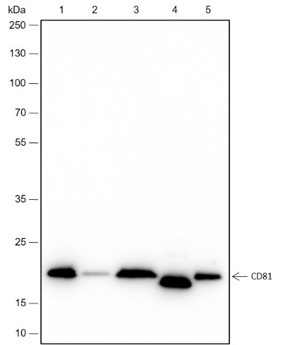
Rabbit Anti-TAPA1/CD81 antibody
26 kDa cell surface protein TAPA 1; 26 kDa cell surface protein TAPA-1; 26 kDa cell surface protein TAPA1; CD 81; CD81 antigen; CD81 molecule; CD81_HUMAN; CVID6; S5.7; TAPA 1; Target of the antiproliferative antibody 1; Tetraspanin 28; Tetraspanin-28; Tet
View History [Clear]
Details
Product Name TAPA1/CD81 Chinese Name CD81Recombinant rabbit monoclonal anti Alias 26 kDa cell surface protein TAPA 1; 26 kDa cell surface protein TAPA-1; 26 kDa cell surface protein TAPA1; CD 81; CD81 antigen; CD81 molecule; CD81_HUMAN; CVID6; S5.7; TAPA 1; Target of the antiproliferative antibody 1; Tetraspanin 28; Tetraspanin-28; Tetraspanin28; Tspan 28; Tspan-28; Tspan28. Research Area Cell biology immunology Signal transduction Bacteria and viruses lymphocyte b-lymphocyte Immunogen Species Rabbit Clonality Monoclonal Clone NO. 4B4 React Species (predicted: Human, Mouse, Rat, ) Applications WB=1:500-2000
not yet tested in other applications.
optimal dilutions/concentrations should be determined by the end user.Theoretical molecular weight 20kDa Cellular localization The cell membrane Form Liquid Concentration 1mg/ml immunogen Recombinant human TAPA1/CD81 Lsotype IgG Purification affinity purified by Protein A Buffer Solution 0.01M TBS(pH7.4) with 1% BSA, 0.03% Proclin300 and 50% Glycerol. Storage Store at -20 °C for one year. Avoid repeated freeze/thaw cycles. The lyophilized antibody is stable at room temperature for at least one month and for greater than a year when kept at -20°C. When reconstituted in sterile pH 7.4 0.01M PBS or diluent of antibody the antibody is stable for at least two weeks at 2-4 °C. Attention This product as supplied is intended for research use only, not for use in human, therapeutic or diagnostic applications. PubMed PubMed Product Detail The protein encoded by this gene is a member of the transmembrane 4 superfamily, also known as the tetraspanin family. Most of these members are cell-surface proteins that are characterized by the presence of four hydrophobic domains. The proteins mediate signal transduction events that play a role in the regulation of cell development, activation, growth and motility. This encoded protein is a cell surface glycoprotein that is known to complex with integrins. This protein appears to promote muscle cell fusion and support myotube maintenance. Also it may be involved in signal transduction. This gene is localized in the tumor-suppressor gene region and thus it is a candidate gene for malignancies. [provided by RefSeq, Jul 2008].
Function:
May play an important role in the regulation of lymphoma cell growth. Interacts with a 16-kDa Leu-13 protein to form a complex possibly involved in signal transduction. May acts a the viral receptor for HCV.
Subunit:
Plays a critical role in HCV attachment and/or cell entry by interacting with HCV E1/E2 glycoproteins heterodimer. Interacts directly with IGSF8. Interacts with CD53 and SCIMP.
Subcellular Location:
Membrane.
Tissue Specificity:
Hematolymphoid, neuroectodermal and mesenchymal tumor cell lines.
Post-translational modifications:
Protein exists in three forms with molecular masses between 22 and 27 kDa, and is known to carry covalently linked fatty acids.
DISEASE:
Defects in CD81 are the cause of immunodeficiency common variable type 6 (CVID6); also called antibody deficiency due to CD81 defect. CVID6 is a primary immunodeficiency characterized by antibody deficiency, hypogammaglobulinemia, recurrent bacterial infections and an inability to mount an antibody response to antigen. The defect results from a failure of B-cell differentiation and impaired secretion of immunoglobulins; the numbers of circulating B cells is usually in the normal range, but can be low.
Similarity:
Belongs to the tetraspanin (TM4SF) family.
SWISS:
P60033
Gene ID:
975
Database links:Entrez Gene: 975 Human
Omim: 186845 Human
SwissProt: P60033 Human
Unigene: 54457 Human
Product Picture
Primary Ab dilution: 1:2000
Primary Ab incubation condition: 2 hours at room temperature
Secondary Ab: Goat Anti-Rabbit IgG H&L (HRP)
Lysate: 1: Ramos, 2: U87MG, 3: Raji, 4: PC12, 5: Raw264.7
Protein loading quantity: 20 μg
Exposure time: 30 s
Predicted MW: 26 kDa
Observed MW: 20 kDa
References (0)
No References
Bought notes(bought amounts latest0)
No one bought this product
User Comment(Total0User Comment Num)
- No comment



 +86 571 56623320
+86 571 56623320
 +86 18668110335
+86 18668110335

